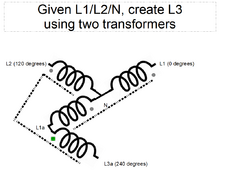timselectric
If I can do it, you can do it.
- Joined
- Feb 5, 2022
- Messages
- 20,135
YesDoes this means the EG4 18k pv can work in 120/208 enviroment?
YesDoes this means the EG4 18k pv can work in 120/208 enviroment?
Two legs is single phase.
Add a center tapped neutral and you have split-phase.
L3 + L1 = phase A
L1 + L2 = phase B
L2 + L3 = phase C
Single phase 208! Only two legs or 2 phases are used out of the 3-phases. In the main panel, L3 is omitted. Is not an actual 3-phase configuration within the property. It's WYE (Star) configuration
No need. 120/208 is fine for all appliances.With an isolation transformer, 208V in, 120/240V split phase out.
A transformer can't create a phase.But if you want to get 3-phase, a couple transformers fed L1-N and L2-N can create something approximating the missing L3.
No need. 120/208 is fine for all appliances.
Two legs is single phase.
Add a center tapped neutral and you have split-phase.
L3 + L1 = phase A
L1 + L2 = phase B
L2 + L3 = phase C
Single phase 120/208 is split-phase.You can't add a center-tapped neutral to 208V of 120/208Y.
You can use the neutral of 120/208Y, 120V or 208V for appliances as you say.
I meant if you want split-phase, you have to use a 208 : 120/240V transformer and ground the derived neutral.
A transformer can't create a phase.
You have to put 3-phase in to get 3-phase out.

A transformer can't create phases.Correct, but if I have L1, L2, N from 3-phase 120/208Y L1, L2, L3 N (my unit was not given L3),
I can synthesize L3 from L1 and L2, which are 120 degrees apart.
Put a 120/240V auto-transformer between L1 and N, creating split-phase 120/240V. I'll call the created phase L1a to distinguish from the other phases.
L1a is 180 degrees apart from L1, that is to say it is inverted. (You will say it is not 180 degrees because it is derived from L1, so let's just agree it is inverted.)
Take another transformer with two 120V windings, but don't connect them in series as auto-transfomer.
Connect one 120V winding between L2 and N.
Connect other 120V winding to L1a and call other end L3a. (have to get polarity right.)
L3a will look like the L3 that wasn't brought over.
I think you know you can make "6 phase" from 3-phase, really just 3x split phase. Smoother ripple if rectified. That's connecting primary and secondary windings of each transformer together. Makes a phase 180 degrees apart, i.e. inverted.
But you can also connect secondary of one transformer to primary of another, making a 60 degree offset and a higher voltage.
Zig-zag transformers do this.

Zigzag transformer - Wikipedia
en.wikipedia.org
Easy to understand graphically.
Similarly, if you have 2-phase (90 degrees apart) you can make 3-phase. Not as difficult to understand as adding vectors with 60 or 120 degree angles.
Yes, but it's irrelevant to the owner of the apart where the EG4 18k with 120/208 configuration will be installed.Correct
But the 3 phases are equally distributed through the different apartments.
First apartment L1,L2, N
Second apartment L2, L3, N
Third apartment L3, L1, N
And so on.....
CorrectYes, but it's irrelevant to the owner of the apart where the EG4 18k pv with 120/208 configuration will be installed.
A transformer can't create phases.
Phasing is timing. A transformer can't change the timing.
No, it can't.Give me vectors of 0 degrees and 120 degrees, and with transformers I can create another one at 240 degrees. (bisects the angle, and inverse.)
No, it can't.
It can only change the voltage.
To change or create timing (phasing).
You either need a rotating mass, or electronic switching.

But you still have to have a 3-phase source. To get the 120° vectors.Those are needed to get from single-phase to 3 phase.
Once you have two phases, like L1 and L2, you can create additional angles from those.
Look at how two transformers can make vectors off each other, so given L1-N and L2-N, the 0 degree and 120 degree phases, can synthesize L3-N which is 240 degrees.
View attachment 225751
Since he has an 18k unit, I was wondering if one could combine it with the EG-3000EHV to get 3phase output. Since the 3000EHV can be configured as part of a 3-phase system.As far as I can tell from the documentation, 2 inverters would be needed for the 3-phase input. However, I will see what I can find out.
NoSince he has an 18k unit, I was wondering if one could combine it with the EG-3000EHV to get 3phase output. Since the 3000EHV can be configured as part of a 3-phase system.


